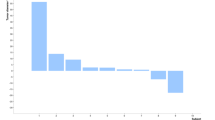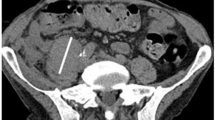Abstract
Ad-ISF35 is an adenovirus (Ad) vector that encodes a mouse–human chimeric CD154. Ad-ISF35 induces activation of chronic lymphocytic leukemia (CLL) cells converting them into CLL cells capable of promoting immune recognition and anti-leukemia T-cell activation. Clinical trials in humans treated with Ad-ISF35-transduced leukemia cells or intranodal injection of Ad-ISF35 have shown objective clinical responses. To better understand the biology of Ad-ISF35 and to contribute to its clinical development, we preformed studies to evaluate biodistribution, persistence and toxicity of repeat dose intratumoral administration of Ad-ISF35 in a mouse model. Ad-ISF35 intratumoral administration induced tumor regression in more than 80% of mice bearing A20 tumors. There were no abnormalities in the serum chemistry. Mice receiving Ad-ISF35 presented severe extramedullary hematopoiesis and follicular hyperplasia in the spleen and extramedullary hematopoiesis with lymphoid hyperplasia in lymph nodes. After Ad-ISF35 injection, the vector was found primarily in the injected tumors with a biodistribution pattern that showed a rapid clearance with no evidence of Ad-ISF35 accumulation or persistence in the injected tumor or peripheral organs. Furthermore, pre-existing antibodies against Ad-5 did not abrogate Ad-ISF35 anti-tumor activity. In conclusion, intratumoral administration of Ad-ISF35 induced tumor regression in A20 tumor bearing mice without toxicities and with no evidence of vector accumulation or persistence.
This is a preview of subscription content, access via your institution
Access options
Subscribe to this journal
Receive 12 print issues and online access
$259.00 per year
only $21.58 per issue
Buy this article
- Purchase on Springer Link
- Instant access to full article PDF
Prices may be subject to local taxes which are calculated during checkout




Similar content being viewed by others
References
Ma DY, Clark EA . The role of CD40 and CD154/CD40L in dendritic cells. Semin Immunol 2009; 21: 265–272.
Buhmann R, Nolte A, Westhaus D, Emmerich B, Hallek M . CD40-activated B-cell chronic lymphocytic leukemia cells for tumor immunotherapy: stimulation of allogeneic versus autologous T cells generates different types of effector cells. Blood 1999; 93: 1992–2002.
Serba S, Schmidt J, Wentzensen N, Ryschich E, Märten A . Transfection with CD40L induces tumour suppression by dendritic cell activation in an orthotopic mouse model of pancreatic adenocarcinoma. Gut 2008; 57: 344–351.
Cerutti A, Puga I, Cols M . Innate control of B cell responses. Trends Immunol 2011; 32: 202–211.
Kato K, Cantwell MJ, Sharma S, Kipps TJ . Gene transfer of CD40-ligand induces autologous immune recognition of chronic lymphocytic leukemia B cells. J Clin Invest 1998; 101: 1133–1141.
Chu P, Wierda WG, Kipps TJ . CD40 activation does not protect chronic lymphocytic leukemia B cells from apoptosis induced by cytotoxic T lymphocytes. Blood 2000; 95: 3853–3858.
Chantrain CF, Feron O, Marbaix E, DeClerck YA . Bone marrow microenvironment and tumor progression. Cancer Microenviron 2008; 1: 23–35.
Mueller MM, Fusenig NE . Friends or foes—bipolar effects of the tumour stroma in cancer. Nat Rev Cancer 2004; 4: 839–849.
Joyce JA . Therapeutic targeting of the tumor microenvironment. Cancer Cell 2005; 7: 513–520.
Herishanu Y, Pérez-Galán P, Liu D, Biancotto A, Pittaluga S, Vire B et al. The lymph node microenvironment promotes B-cell receptor signaling, NF-kappaB activation, and tumor proliferation in chronic lymphocytic leukemia. Blood 2011; 117: 563–574.
Beatty GL, Chiorean EG, Fishman MP, Saboury B, Teitelbaum UR, Sun W et al. CD40 agonists alter tumor stroma and show efficacy against pancreatic carcinoma in mice and humans. Science 2011; 331: 1612–1616.
Tong AW, Stone MJ . Prospects for CD40-directed experimental therapy of human cancer. Cancer Gene Ther 2003; 10: 1–13.
Eliopoulos AG, Young LS . The role of the CD40 pathway in the pathogenesis and treatment of cancer. Curr Opin Pharmacol 2004; 4: 360–367.
Law CL, Grewal IS . Therapeutic interventions targeting CD40L (CD154) and CD40: the opportunities and challenges. Adv Exp Med Biol 2009; 647: 8–36.
Wierda WG, Cantwell MJ, Woods SJ, Rassenti LZ, Prussak CE, Kipps TJ et al. CD40-ligand (CD154) gene therapy for chronic lymphocytic leukemia. Blood 2000; 96: 2917–2924.
Wierda WG, Castro JE, Aguillon R, Sampath D, Jalayer A, McMannis J et al. A phase I study of immune gene therapy for patients with CLL using a membrane-stable, humanized CD154. Leukemia 2010; 24: 1893–1900.
Services USDoHaH. In: Administration FaD, Research CfBEa (eds). Guidance for Industry: Gene Therapy Clinical Trials—Observing Subjects for Delayed Adverse Events. B. Considerations for preclinical study design to assess vector biodistribution and persistence. Rockville, MD, USA, 2006.
Biosystems A . Creating Standard Curves with Genomic DNA or Plasmid DNA Templates for use in Quantitative PCR. F Hoffmann-La Roche Ltd: Basel.
Suttie AW . Histopathology of the spleen. Toxicol Pathol 2006; 34: 466–503.
MacGill RS, Davis TA, Macko J, Mauceri HJ, Weichselbaum RR, King CR et al. Local gene delivery of tumor necrosis factor alpha can impact primary tumor growth and metastases through a host-mediated response. Clin Exp Metastasis 2007; 24: 521–531.
Kim JH, Lee YS, Kim H, Huang JH, Yoon AR, Yun CO . Relaxin expression from tumor-targeting adenoviruses and its intratumoral spread, apoptosis induction, and efficacy. J Natl Cancer Inst 2006; 98: 1482–1493.
Hu Z, Garen A . Intratumoral injection of adenoviral vectors encoding tumor-targeted immunoconjugates for cancer immunotherapy. Proc Natl Acad Sci USA 2000; 97: 9221–9225.
Lohr F, Huang Q, Hu K, Dewhirst MW, Li CY . Systemic vector leakage and transgene expression by intratumorally injected recombinant adenovirus vectors. Clin Cancer Res 2001; 7: 3625–3628.
Reay J, Kim SH, Lockhart E, Kolls J, Robbins PD . Adenoviral-mediated, intratumor gene transfer of interleukin 23 induces a therapeutic antitumor response. Cancer Gene Ther 2009; 16: 776–785.
Pande K, Ueda R, Machemer T, Sathe M, Tsai V, Brin E et al. Cancer-induced expansion and activation of CD11b+ Gr-1+ cells predispose mice to adenoviral-triggered anaphylactoid-type reactions. Mol Ther 2009; 17: 508–515.
Oberholzer C, Oberholzer A, Tschoeke SK, Minter RM, Bahjat FR, LaFace D et al. Influence of recombinant adenovirus on liver injury in endotoxicosis and its modulation by IL-10 expression. J Endotoxin Res 2004; 10: 393–401.
Mahasreshti PJ, Kataram M, Wang MH, Stockard CR, Grizzle WE, Carey D et al. Intravenous delivery of adenovirus-mediated soluble FLT-1 results in liver toxicity. Clin Cancer Res 2003; 9: 2701–2710.
Manickan E, Smith JS, Tian J, Eggerman TL, Lozier JN, Muller J et al. Rapid Kupffer cell death after intravenous injection of adenovirus vectors. Mol Ther 2006; 13: 108–117.
Xu Z, Smith JS, Tian J, Byrnes AP . Induction of shock after intravenous injection of adenovirus vectors: a critical role for platelet-activating factor. Mol Ther 2010; 18: 609–616.
Cheson BD, Bennett JM, Grever M, Kay N, Keating MJ, O'Brien S et al. National Cancer Institute-sponsored Working Group guidelines for chronic lymphocytic leukemia: revised guidelines for diagnosis and treatment. Blood 1996; 87: 4990–4997.
Hallek M, Cheson BD, Catovsky D, Caligaris-Cappio F, Dighiero G, Döhner H et al. Guidelines for the diagnosis and treatment of chronic lymphocytic leukemia: a report from the International Workshop on Chronic Lymphocytic Leukemia updating the National Cancer Institute-Working Group 1996 guidelines. Blood 2008; 111: 5446–5456.
Lozier JN, Csako G, Mondoro TH, Krizek DM, Metzger ME, Costello R et al. Toxicity of a first-generation adenoviral vector in rhesus macaques. Hum Gene Ther 2002; 13: 113–124.
Eggerman TL, Mondoro TH, Lozier JN, Vostal JG . Adenoviral vectors do not induce, inhibit, or potentiate human platelet aggregation. Hum Gene Ther 2002; 13: 125–128.
Wolins N, Lozier J, Eggerman TL, Jones E, Aguilar-Córdova E, Vostal JG . Intravenous administration of replication-incompetent adenovirus to rhesus monkeys induces thrombocytopenia by increasing in vivo platelet clearance. Br J Haematol 2003; 123: 903–905.
Cichon G, Schmidt HH, Benhidjeb T, Löser P, Ziemer S, Haas R et al. Intravenous administration of recombinant adenoviruses causes thrombocytopenia, anemia and erythroblastosis in rabbits. J Gene Med 1999; 1: 360–371.
Inwald DP, McDowall A, Peters MJ, Callard RE, Klein NJ . CD40 is constitutively expressed on platelets and provides a novel mechanism for platelet activation. Circ Res 2003; 92: 1041–1048.
Lievens D, Eijgelaar WJ, Biessen EA, Daemen MJ, Lutgens E . The multi-functionality of CD40L and its receptor CD40 in atherosclerosis. Thromb Haemost 2009; 102: 206–214.
Cotter MJ, Zaiss AK, Muruve DA . Neutrophils interact with adenovirus vectors via Fc receptors and complement receptor 1. J Virol 2005; 79: 14622–14631.
Wang Y, Yang Z, Liu S, Kon T, Krol A, Li CY et al. Characterisation of systemic dissemination of nonreplicating adenoviral vectors from tumours in local gene delivery. Br J Cancer 2005; 92: 1414–1420.
Wang Y, Wang H, Li CY, Yuan F . Effects of rate, volume, and dose of intratumoral infusion on virus dissemination in local gene delivery. Mol Cancer Ther 2006; 5: 362–366.
Bazan-Peregrino M, Carlisle RC, Purdie L, Purdie L, Seymour LW . Factors influencing retention of adenovirus within tumours following direct intratumoural injection. Gene Ther 2008; 15: 688–694.
Sparwasser T, Hültner L, Koch ES, Luz A, Lipford GB, Wagner H . Immunostimulatory CpG-oligodeoxynucleotides cause extramedullary murine hemopoiesis. J Immunol 1999; 162: 2368–2374.
Harvey BG, Hackett NR, El-Sawy T, Rosengart TK, Hirschowitz EA, Lieberman MD et al. Variability of human systemic humoral immune responses to adenovirus gene transfer vectors administered to different organs. J Virol 1999; 73: 6729–6742.
Chen Y, Yu DC, Charlton D, Henderson DR . Pre-existent adenovirus antibody inhibits systemic toxicity and antitumor activity of CN706 in the nude mouse LNCaP xenograft model: implications and proposals for human therapy. Hum Gene Ther 2000; 11: 1553–1567.
Chirmule N, Propert K, Magosin S, Qian Y, Qian R, Wilson J . Immune responses to adenovirus and adeno-associated virus in humans. Gene Ther 1999; 6: 1574–1583.
Bramson JL, Hitt M, Gauldie J, Graham FL . Pre-existing immunity to adenovirus does not prevent tumor regression following intratumoral administration of a vector expressing IL-12 but inhibits virus dissemination. Gene Ther 1997; 4: 1069–1076.
Mercier S, Rouard H, Delfau-Larue MH, Eloit M . Specific antibodies modulate the interactions of adenovirus type 5 with dendritic cells. Virology 2004; 322: 308–317.
Grossmann ME, Brown MP, Brenner MK . Antitumor responses induced by transgenic expression of CD40 ligand. Hum Gene Ther 1997; 8: 1935–1943.
Acknowledgements
We thank Memgen LLC for providing Ad-ISF35 GMP quality; Explora Biolabs for performing the in vivo studies; and the Alliance for Cancer Gene Therapy (TJK, JEC, JMC, MU) and FDA-OOPD-R01-3427 Grant (JEC, TJK).
Author information
Authors and Affiliations
Corresponding authors
Ethics declarations
Competing interests
TJK receives stock options as a payment for providing consulting services to Memgen LLC. The University of California owns the patent for Ad-ISF35 and licenses it to Memgen LLC. The other authors declare no competing financial interests.
Additional information
Supplementary Information accompanies the paper on Cancer Gene Therapy website
Supplementary information
Rights and permissions
About this article
Cite this article
Melo-Cardenas, J., Urquiza, M., Kipps, T. et al. Intratumoral delivery of CD154 homolog (Ad-ISF35) induces tumor regression: analysis of vector biodistribution, persistence and gene expression. Cancer Gene Ther 19, 336–344 (2012). https://doi.org/10.1038/cgt.2012.6
Received:
Revised:
Accepted:
Published:
Issue Date:
DOI: https://doi.org/10.1038/cgt.2012.6
Keywords
This article is cited by
-
Intratumoral CD40 activation and checkpoint blockade induces T cell-mediated eradication of melanoma in the brain
Nature Communications (2017)



